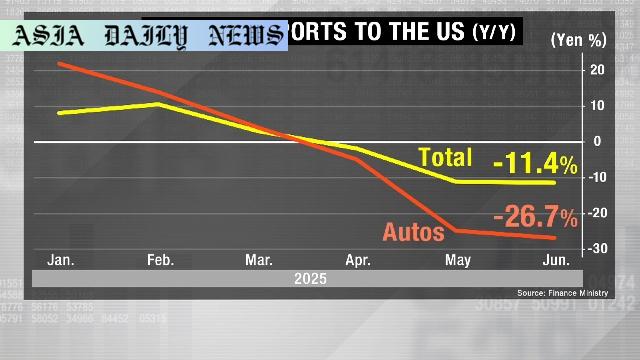Exports: Japan’s June exports to the US drop for the third consecutive month, especially in the auto sector, reflecting tariff impacts.
Japan’s exports to the US fell for the third straight month in June.
Auto exports dropped significantly by 26.7% due to tariffs.
In total, Japan’s exports for June fell 11.4% in yen terms.
Despite the decline, Japan maintained a slight trade surplus of $1.03 billion.

The Decline in Japan’s Exports to the US
The Japanese Finance Ministry recently reported a third consecutive monthly decline in the country’s exports to the United States. In June, exports fell by 11.4% in yen terms compared to the same month last year. This marks a significant hit to Japan’s economy, particularly in the auto industry, which bore the brunt of the tariffs imposed by the Trump administration. Carmakers, struggling to adapt to these changes, have resorted to shipping less expensive models or cutting prices to offset the increased financial burdens.
The auto sector’s decline was especially pronounced, with a 26.7% drop in export value. While the number of vehicles shipped to the US actually increased, the average price per vehicle dipped by nearly 30% to approximately $22,800. This underscores the strategic adjustments made by Japanese car manufacturers to remain competitive amidst heightened trade duties.
Japan’s Overall Export and Trade Performance
On a broader scale, Japan’s total exports were valued at about $62 billion in June, reflecting a modest decline of 0.5% from the previous year. Imports, meanwhile, experienced a slight uptick of 0.2%, amounting to $61 billion. As a result, Japan managed to secure a marginal trade surplus of $1.03 billion for the month. However, the broader picture for the first six months of the year paints a more concerning story, with Japan recording a trade deficit of over 2.2 trillion yen, equivalent to almost $15 billion.
This worrying trend indicates the challenges that Japan faces in maintaining its trade balance, particularly with one of its largest trading partners, the United States. The tariffs have not only influenced trade dynamics but have also put additional pressure on Japanese manufacturers to revise their pricing and production strategies to mitigate losses.
Impact on the Auto Industry
The tariffs have undeniably left a significant mark on the Japanese automotive sector. Automobiles are one of Japan’s key exports to the US, and the 26.7% drop in value highlights the extent of the impact. While efforts to adjust pricing have allowed for an increase in the number of vehicles exported, the lower average prices are taking a toll on overall revenue. This dual dynamic points to the need for long-term strategies to address these challenges, potentially through innovation, cost management, or diversification of export markets.
Japanese carmakers are also facing competition from local and international manufacturers, further exacerbating their predicament under the current trade conditions. This complex interplay of factors makes the recovery of the auto sector a critical aspect of Japan’s broader economic resurgence.
Future Outlook for Japan’s Trade
Looking ahead, Japan faces the dual challenge of navigating trade tensions with the United States and addressing its domestic economic concerns. While the slight trade surplus in June offers a glimmer of hope, the significant deficit across the first half of the year underscores the hurdles that lie ahead. Tariff-related uncertainties continue to loom large, requiring the Japanese government and businesses to exercise strategic foresight.
It remains to be seen how Japan will address the evolving trade landscape. Measures such as negotiations for tariff reductions, diversification of export markets, and fostering innovation in key industries could play a pivotal role in shaping future outcomes. Additionally, strengthening economic ties with other regions might help mitigate the impacts of ongoing trade disputes.
In conclusion, the decline in Japan’s exports to the United States is a clear indication of the challenges posed by current global trade dynamics. While the road to recovery may be long, strategic and collaborative efforts could help Japan in regaining its economic momentum.



Commentary
The Challenges of Tariffs in Global Trade
Japan’s struggle with declining exports to the US serves as a poignant reminder of the far-reaching impacts of trade policies. The imposition of tariffs under the Trump administration has not only constrained Japan’s exports but has also forced its industries to rethink their pricing strategies and adapt to an increasingly competitive landscape. Global trade dynamics are immensely complex, and this situation highlights how policy decisions in one country can ripple across the globe, affecting economies and industries on a large scale.
The Auto Industry at a Crossroads
The steep decline in Japan’s auto exports to the US underscores the vulnerability of even the most robust industries to shifting trade policies. Japanese automakers, renowned for their technological innovation and quality, now find themselves at a crossroads. They must navigate the dual challenges of maintaining profitability while adapting to an evolving market shaped by tariffs and increased competition. Collaborative efforts between policymakers and industries could be instrumental in mitigating these challenges and paving the way for sustainable growth.
The Road Ahead for Japan’s Trade
Looking toward the future, the Japanese government and businesses have their work cut out for them. Diversification of export markets, reduced dependence on single trading partners, and continued innovation in key industries may be vital to weathering the storm. The slight trade surplus in June is an encouraging sign, but it will take long-term vision and determination to reverse the broader trade deficit trends. More than just economic reports, these developments serve as an important lesson on the significance of adaptability in the modern global trading system.